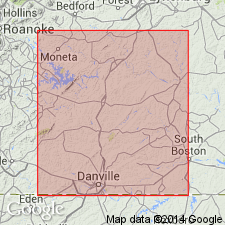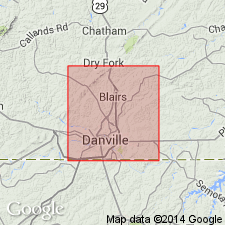
- Usage in publication:
-
- Cedar Forest Formation
- Modifications:
-
- Named
- Dominant lithology:
-
- Conglomerate
- AAPG geologic province:
-
- Piedmont-Blue Ridge province
Summary:
The Cedar Forest Formation is here named for red and maroon conglomerate containing fragments of older crystalline rocks, interbedded with siltstone and shale in the Danville basin, VA. It consists of narrow exposures of conglomerate along the east and west borders of the basin. Disconformably overlies the Leakesville and Dry Fork Formations. Thickness at type section is 87 ft (26 m). Age is Late Triassic.
Source: GNU records (USGS DDS-6; Reston GNULEX).

- Usage in publication:
-
- Cedar Forest Formation†
- Modifications:
-
- Abandoned
- AAPG geologic province:
-
- Piedmont-Blue Ridge province
Summary:
The Cedar Forest Formation is here abandoned because basin margin conglomerates of the Cedar Forest are assigned to the Dry Fork Formation. Detailed mapping shows that the conglomerate is interbedded and intertongues with sandstone of the Dry Fork and that the Dry Fork and Cedar Forest are lateral facies equivalents.
Source: GNU records (USGS DDS-6; Reston GNULEX).
For more information, please contact Nancy Stamm, Geologic Names Committee Secretary.
Asterisk (*) indicates published by U.S. Geological Survey authors.
"No current usage" (†) implies that a name has been abandoned or has fallen into disuse. Former usage and, if known, replacement name given in parentheses ( ).
Slash (/) indicates name conflicts with nomenclatural guidelines (CSN, 1933; ACSN, 1961, 1970; NACSN, 1983, 2005, 2021). May be explained within brackets ([ ]).

